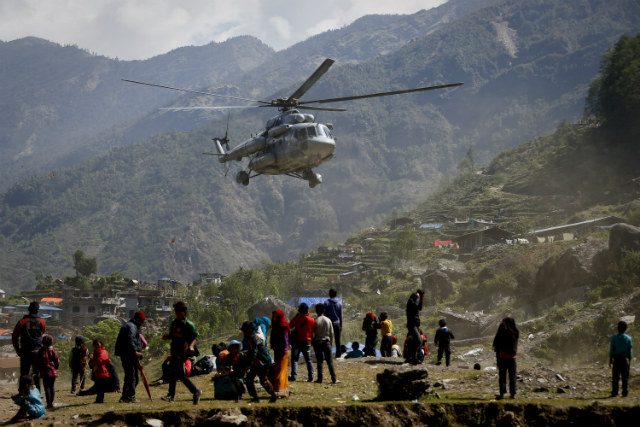SUMMARY
This is AI generated summarization, which may have errors. For context, always refer to the full article.

KATHMANDU, Nepal – More than a week after Nepal’s devastating earthquake, large swathes of the Himalayan nation have yet to receive any outside help as aid workers battle landslides, avalanches and a helicopter shortage to reach communities in some of the world’s remotest terrain.
Relief workers say it is now a race against time to get desperately needed shelter, food and clean water to survivors in the far-flung mountain villages flattened by the disaster before the monsoon rains begin in June.
But many of the worst-hit communities are tiny villages perched on the side of mountains that are inaccessible by road and where it is difficult or impossible for helicopters to land.
The country’s poor infrastructure and a weak national government beset by in-fighting among coalition partners have compounded the difficulties of mounting a vast emergency relief operation in the world’s highest mountains.
“One of the big challenges of working in Nepal, and we knew that this would happen should a major earthquake happen here, is the nature of the terrain,” the UN humanitarian chief Valerie Amos told Agence France-Presse in Kathmandu.
“There are a lot of villages which are on the top of hills. They’re quite small villages. But there are no real roads that go up to those villages. And we know that there are quite a few areas like that, because the epicenter is in a mountainous region.
“It’s not been possible to land even small helicopters (in some places) because there have been landslides.”
‘Calamity of enormous proportions’
Indian Air Force pilot Avik Abhijit S Bali described how he had to abandon efforts to rescue survivors from a remote village in Gorkha, one of the worst-hit districts, because he could not land.
“We tried for 20 minutes but there was no possibility of landing in a village that was on a slope and covered in debris from collapsed houses,” he told Agence France-Presse.
The Nepal government has said it faces a severe shortage of both helicopters and heavy machinery to clear roads blocked by landslides after the 7.8-magnitude quake that hit on April 25, killing more than 7,000 people and flattening entire villages.
The army has just 7 helicopters of its own. While India has lent the country another 6 for rescue and relief efforts, it desperately needs more help to transport aid materials.
“This was a calamity of enormous proportions and the relief operations have been a challenge given the resources we have,” said Information Minister Minendra Rijal.
“We are putting all our resources into increasing the effectiveness of our relief efforts. We have deployed people to reach every affected district by air, road or even on foot.”
90% of homes destroyed
With authorities saying up to 90% of homes in the two worst-affected districts have been destroyed, the United Nations said providing shelter is the priority.
It estimates more than 8 million survivors are in need of aid. It has received reports of desperate survivors clamoring to get onto helicopters that evacuate the badly wounded from rural areas and forcing relief trucks off the road.
“Remarkably few modern, concrete, buildings have been affected in the capital,” said Nepal expert and former UN official John Bevan in a blog post this week.
“In the countryside, however, most buildings are old, made of mud or weak bricks and stand on vertiginous slopes. These are the remote hill villages which it would appear have borne the main brunt of the quake.”
Amos said there had been reports of some areas getting repeated aid deliveries, while others had still received nothing.
“What we do know is that there is a lot more need out there than the places we are able to get to,” she said.
“Our priority now is really to try to reach those people, get immediate assistance to them.”
The government of landlocked Nepal has also faced criticism for holding up foreign relief deliveries at customs, with reports of aid trucks being turned away at the border with India because they did not have the correct documentation.
Kathmandu’s tiny international airport has been operating round the clock to allow aid flights to land, but a shortage of parking space has meant some have had to be turned away.
On Sunday, May 3, it said it was imposing a weight restriction on planes for fear that the only runway may have sustained damage in the quake and the multiple aftershocks that have followed.
“This runway is the only lifeline for Kathmandu,” said airport manager Birendra Prasad Shrestha. “If it goes, everything goes.” – Claire Cozens, AFP/Rappler.com
Add a comment
How does this make you feel?
There are no comments yet. Add your comment to start the conversation.